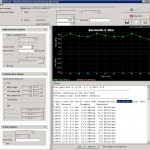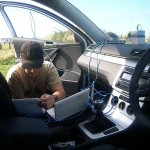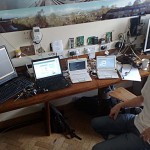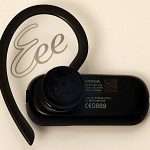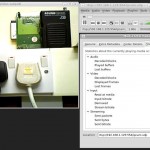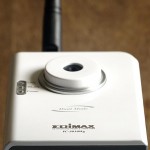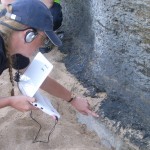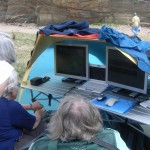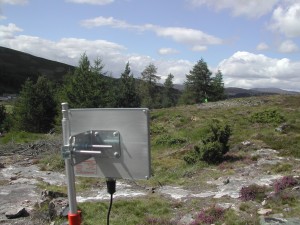Screen shots
Description
The Portable VoWLAN Toolkit is a battery-powered wireless local area network, optimised for voice and video data. Developed for use in university geology field courses, the toolkit provides a 802.11g WiFi network, a VoIP telephony server, and streaming video. During a field trip students and lecturers can use VoIP softphones to talk to one another, and any web standards compliant browser to view streaming video and collected photos. Although developed to improve student access to geology fieldwork, the resulting generic toolkit can be applied to support any mobile learning context where live communication is required.
In developing the Portable VoWLAN Toolkit three characteristics of the educational experience have helped to focus our activities:
- Live communication: Supporting live communication is essential to delivering remote access to the field site.
- Speed of deployment: The students visit multiple locations during the same day, so rapid deployment is essential.
- Replicability: The Toolkit should be usable by students and lecturers, and a technician, or any other motivated enthusiast, should be able to build their own toolkit from commercially available off-the-shelf equipment and open-source software.
Related links
- Portable VoWLAN Technical Report – An explanation of the technology we used and how we used it.
- Portable VoWLAN Educational Report – An overview of how we’ve used this equipment in OU geology field courses.
Project team
- Trevor Collins (t.d.collins@open.ac.uk) – KMi, The Open University, UK
- John Lea (san@spc.org) – Community networking consultant
Websites
- Portable VoWLAN Blog – The day by day account of what we did (see list of posts below).
- Portable VoWLAN Wiki pages – An overview of the Portable VoWLAN project and the people involved.
- JISC PIMS entry – Portable VoWLAN (Ref 1334)
- Enabling Remote Activity (ERA) project website
- ERA project wiki
Project blog posts
- ERA: Portable VoWLAN project – Thanks to a Rapid Innovation Grant from JISC we are investigating the potential use of Voice over Internet Protocol (VoIP) telephony to provide audio and video communication over a portable wireless network.
- First VoWLAN field tests – Today we did our first set of antenna tests as part of the JISC funded Portable VoWLAN project.
- Fieldwork meeting with Professor Bob Spicer – met with Bob Spicer an OU lecturer who we will be working with when we go to our Durham residential school at the beginning of August.
- Second field tests at Old Wolverton – Today we carried out our second set of field tests. This time using our new Ubiquity Nanostation2 wifi routers.
- Clifftop multi-hop: Scremerston – Today’s visit brought us to the dramatic coastal features of Scremerston, just south of Berwick-upon-Tweed.
- Thursday: Configuration and Demonstration – Today we had a morning checking over kit, and trying out further configurations.
- The curse of ERA strikes again! (sunshine 🙂 ) – The curse of ERA – bringing sunny weather to field trips – strikes again!
- Durham field tests – The ERA team has just returned from a week-long field trip in the North East of England, based at Durham University.
- Googlemaps links – Some annotated maps of our adventures on the North East coast.
- Investigating video upgrades – During our field trials, it became clear that the built-in video camera on the Asus EEE 901 (and 701) is in the wrong place for our needs.
- Using smartphones as …phones. – Could it be that the way to make a telephone call on a geology site would be to use a telephone?
- Sipdroid works on G1 Android 1.5 – Good news sipdroid works with our Asterisk server.
- Testing IP cameras – pt.1 – Since ERA already has some IP cameras from previous years, it’s probably time to dust them off and try them out with the new Asus 901s.
- Testing IP cameras, part 2 – Now we’ve seen that the nice and simple DCS-900 is pretty handy when controlled from Linux with no ActiveX. Time to examine the much more complex DCS-3220g.
- Axis of Openness – Frustrated with the poor image quality and/or interfaces of our existing IP cameras, it’s time to search for better alternatives.
- UNR, revisited – One of our netbooks needed rebuilding recently, and since we’ve not documented the installation procedure we used, now seems like a good time.
- Disk Imaging with Clonezilla. – Once our netbooks have their operating systems and software installed on them, when they’ve been tested and tinkered with, it’d be a shame to have to do all that again without good reason.
- Set up Asterisk conference calling with MeetMe. – I made my first (2-way) conference call on Asterisk/Meetme just now.
- MeetMe testing – Last Wednesday we did some testing of our Asterisk MeetMe setup.
- Trunking calls between Asterisk servers with IAX2. – At the end of last week we managed to create an IAX to IAX trunk between 2 asterisk servers on the local wired LAN.
- First look at the Axis video encoder – Yesterday was our first opportunity to take the brand new Axis Q7401 video encoder for a test drive.
- Cheap IP cameras: the Edimax IC-3010WG – A much cheaper solution for IP video than the Axis Q7401, the Edimax IC-3010WG network camera is only £80 from use-IP.co.uk.
- Ubuntu 9.10 and Bluetooth audio – Following the release of the new 9.10 ‘Karmic Koala’ version of Ubuntu, we installed it on one of the Asus 901s.
- Nokia LD-3W with Ricoh Caplio 500SE – We’ve just tried a Nokia LD-3W bluetooth GPS dongle with the Ricoh Caplio 500SE camera we’ve been using for taking photographs – and it rocks.

